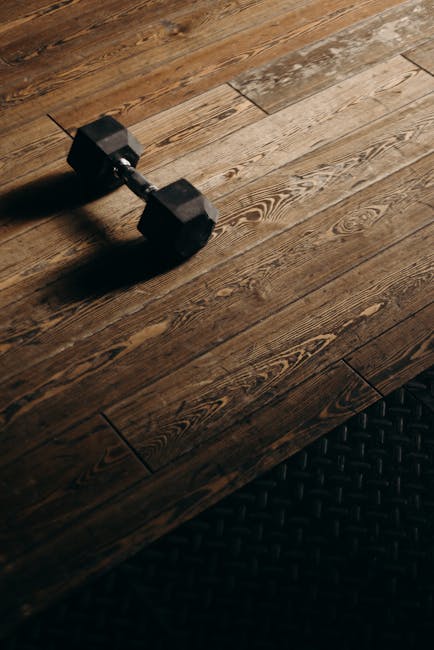Are you tired of feeling pain every time you lift weights? Do you feel like you’re training for a nursing home convention instead of the Olympics? Fear not, fellow gym rat, for we have the solution to your weight lifting induced elbow tendonitis woes. In this professional guide, we’ll teach you all the tips and tricks for lifting heavy without suffering the consequences. So grab your protein shake and let’s get started!
Contents
- 1 Understanding Weight Lifting Induced Elbow Tendonitis
- 2 Identifying Symptoms of Elbow Tendonitis in Weight Lifters
- 3 Causes of Elbow Tendonitis from Weight Lifting & How to Prevent Them
- 4 Treatment of Weight Lifting Induced Elbow Tendonitis: Best Practices
- 5 Recovering from Elbow Tendonitis while Maintaining Fitness Gains
Understanding Weight Lifting Induced Elbow Tendonitis
So, you finally decided to hit the gym and build your muscles, but wait! What is this sharp pain in your elbow? Elbow tendonitis is a common injury that often results from lifting heavy weights without proper form or overdoing it with weight training.
- It hurts to grip onto anything tightly or even lift your water bottle.
- You’ve considered trying to use your feet for more everyday tasks, but that seems impractical.
- You now refer to yourself as the “one-armed bandit” because you can only use one arm to do everyday functions.
The good news is that elbow tendonitis is treatable and preventable. The bad news is that you’ll need to take some time off from your weight lifting routine to let your elbow heal. Trust us, we know it’s not what you want to hear, but it’s necessary for your recovery.

Identifying Symptoms of Elbow Tendonitis in Weight Lifters
Ah, the joys of lifting weights – the sweat, the burn, the occasional grunt that makes everyone in the gym turn their heads in your direction. But sometimes, all that exertion can come with a price. Elbow tendonitis is a common condition that weightlifters might experience, and it can put a damper on your routine if you’re not careful. Here are some symptoms you should watch out for:
- Pain on the outside of your elbow: This is usually the first sign that something is wrong. You might feel a dull ache that gets worse as you lift weights. It’s not the same as the burn you feel when you’re pushing yourself – it’s a more constant discomfort that lingers even after you’re done working out.
- Stiffness in your elbow: If you’re suddenly having trouble extending your arm all the way, or if your elbow feels tight and inflexible, it could be a sign of tendonitis. This can make lifting weights more difficult, since you might not be able to achieve a full range of motion.
- Tenderness when you touch your elbow: If your elbow feels sore when you press on the outside of it, that’s another clue that you might have tendonitis. You might also notice some swelling around the affected area.
If any of these symptoms sound familiar, don’t panic – elbow tendonitis is treatable, and with some rest and proper care, you can get back to lifting weights in no time. In the meantime, though, you might want to ease up on the heavy lifting and focus on exercises that won’t aggravate your elbow. You could also try applying ice to the area or taking over-the-counter pain medication to help relieve some of the discomfort. Remember, it’s better to take it easy for a little while than to push yourself too hard and risk making the condition worse. Happy lifting!
Causes of Elbow Tendonitis from Weight Lifting & How to Prevent Them
Oh boy, if you’re a weightlifter, you know the pain that comes with elbow tendonitis. One day you’re lifting, feeling like a champ, and the next day your elbow feels like it’s on fire. But why, oh why, does this happen? Let’s explore some common causes of elbow tendonitis from weightlifting:
- Overuse: When you lift too much weight, too often, your elbow tendons can get overstressed and begin to ache.
- Poor form: If you’re not lifting with proper technique, you’re putting more strain on your tendons, and they may become inflamed.
- Lack of rest: Your tendons need time to recover after lifting. If you don’t take enough rest days, your elbow may pay the price.
Okay, so those are some possible causes of elbow tendonitis. But how can we prevent it? Here are some tips:
- Warm up: Take a few minutes to stretch and warm up your elbows before you start lifting.
- Perfect your form: Make sure you’re lifting with proper technique, and if you’re not sure, hire a coach or trainer to help you.
- Rest and recover: Take rest days and give your tendons a break. And if you do feel some pain, take it easy and give yourself time to heal.
Now that you know some causes and prevention tips for elbow tendonitis, go forth and lift weights (safely and responsibly, of course). And if you do feel that fiery pain in your elbow, don’t ignore it. Take a break, ice it, and give your tendon some love. Happy lifting!
Treatment of Weight Lifting Induced Elbow Tendonitis: Best Practices
Elbow tendonitis is no joke, especially when it’s caused by weight lifting. But fear not, there are ways to treat and prevent this pesky condition.
First things first, ice that elbow. I mean, really ice it. Stick your whole arm in a bucket of ice if you have to, just make sure you’re getting that inflammation down. And while you’re at it, use compression too. Wrap that elbow up like a holiday gift and it’ll thank you later.
Next up, take a break from lifting. I know, I know, it’s hard to resist the siren call of the gym, but trust me on this one. Let your elbow rest and recover. You can still get your fitness fix by doing other exercises that don’t aggravate your tendonitis. Plus, think of all the extra time you’ll have to catch up on your Netflix queue. Win-win.
Finally, work on your form. A lot of the time, weight lifting induced elbow tendonitis can be caused by poor technique. Take the time to really focus on your posture and make sure you’re not putting unnecessary strain on your elbow. And don’t be afraid to ask for help from a trainer or experienced lifter. They can give you pointers on how to lift safely and effectively.
So there you have it, folks. Treat your elbow tendonitis like the delicate flower it is and you’ll be back to lifting in no time. And hey, maybe use this as an excuse to work on your bench press facial expressions. Just saying.
Recovering from Elbow Tendonitis while Maintaining Fitness Gains
Now, listen up folks, elbow tendonitis might sound like a fancy word for being unable to lift your morning cup of coffee, but trust me, it’s a pain in the rear end. The pain can be demoralizing, and the road to recovery can be an arduous journey. But, guess what? It’s not the end of the world. Fitness buffs, don’t fret. You can maintain your gains while recovering from your elbow tendonitis.
So, what do you do? For starters, modify your workouts to accommodate your ailment. If you train with heavy weights, lighten the load, and if you notice that particular workouts aggravate your elbow, ditch them. Focus on low-impact exercises that won’t put strain on your tendons. Think along the lines of swimming, cycling, and stability exercises to maintain your fitness goals.
An important thing to note is that you need to give your body ample rest to heal. Yes, rest is your friend. Your elbow tendonitis is a sign that your body is overworked and needs time to recover. So don’t feel bad about taking a day off or reducing the intensity of your workouts. A little bit of rest now will pay dividends in the future.
- Modify your workouts to accommodate your ailment.
- Focus on low-impact exercises that won’t put strain on your tendons.
- Give your body ample rest to heal.
So there you have it, folks. You don’t have to choose between maintaining your fitness gains and recovering from elbow tendonitis. With a little bit of modification in your workouts and plenty of rest, you’ll be back to doing those bicep curls in no time.
So, what’s the big lesson here?
Well, it’s pretty simple: if you want to avoid weight lifting induced elbow tendonitis, don’t lift weights! Just kidding, we’re not monsters. But seriously, take care of your body. Warm up properly, use proper technique, and know when to call it quits. Don’t push yourself too hard, or you’ll end up with elbows that feel like they’re made of dry pasta.
In all seriousness, elbow tendonitis is nothing to scoff at. It can be painful and debilitating, and it can seriously impede your progress in the gym. But armed with the knowledge you’ve gained from this article, you can help prevent it from happening to you. So go forth, lift weights, and be elbow-tendonitis-free!








Leave A Comment